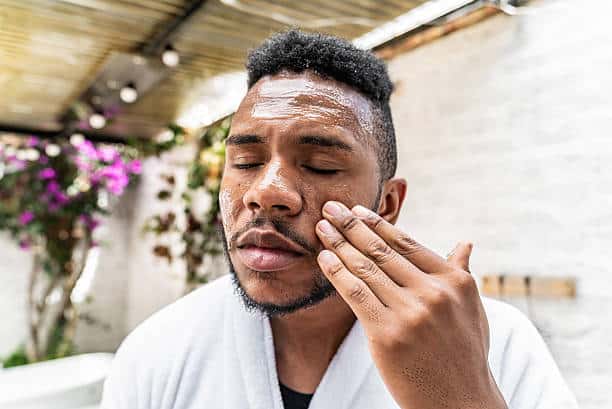Exfoliating for Melanin-Rich Skin: The Best (and Worst) Methods


Ready to unlock your skin’s ultimate potential?
Then you have to try exfoliation. Exfoliation is all about achieving smooth, glowing skin, especially when you have darker skin tones. Darker skin, classified as Fitzpatrick types IV–VI, has more active melanocytes, or cells that produce melanin.
Thanks to this heightened activity, the skin is also more vulnerable to post-inflammatory hyperpigmentation (PIH). When this happens, stubborn dark spots can appear, leading to all kinds of irritation and discomfort.
But here’s the good news. There’s a range of gentle, skin-friendly exfoliation methods that can deliver radiant results without triggering PIH.
Let’s break down the best science-backed options for exfoliating your skin gently and significantly.
RELATED: 5 Natural Remedies For Hyperpigmentation (Dark Spots on Your Neck, Cheek, Belly, Etc)
1. Mandelic Acid
When it comes to exfoliants, chemical alternatives are typically safer than harsh physical scrubs, and mandelic acid is no exception. What’s known as an alpha hydroxy acid (AHA), this acid is actually derived from bitter almonds. It has a large molecular structure, allowing it to penetrate the skin more slowly and gently.
This also reduces irritation, a key trigger for PIH, which promotes cell turnover, reduces hyperpigmentation, and a smoother texture. Mandelic acid can also be used to treat acne in darker skin, given fewer instances of post-treatment darkening.
Thanks to its antibacterial properties, it’s a fantastic way to boost overall skin health. You can also get it in various forms, everything from serums to peels and cleansers. If you need a healthier routine, definitely consider pairing mandelic acid with hydrating ingredients.
For the best results, use a five to 10 percent mandelic acid product, like The Ordinary Mandelic Acid 10% + HA, twice weekly at night. For application, make sure you put it on your skin when it’s clean and dry. Allow it to sit for 10 minutes, then apply a moisturizer.
If you’re out and about in the sun, don’t forget a broad-spectrum SPF 30 or higher. This level of sunscreen protection will ensure you’re fully protected against UV-induced PIH.
2. Enzyme Exfoliants
Enzyme exfoliants are a natural, irritation-free option for darker skin. These products actually rely on fruit-derived enzymes, like papain from papaya and bromelain from pineapple. When used, these enzymes help to dissolve the protein bonds in dead skin cells, removing them without any scrubbing. This is a great, non-abrasive approach that avoids micro tears.
One example is a papaya enzyme mask, which has been linked to improved brightness and reduced dullness after four weeks. You can purchase these exfoliants in creams or gels, or even make your own. Because darker skin is more prone to sensitivity and dehydration, using these products properly is key.
For people with conditions such as keratosis pilaris, or bumpy skin, these exfoliants go a long way. And all it takes is a few minutes as a mask or cleanser.
If you’re looking for top brands, definitely consider Paula’s Choice Calm Redness Relief 1% BHA Lotion Exfoliant. You can use it once weekly as a 10-minute mask for optimum benefits. Follow up with a hydrating toner and moisturizer, and you’re good to go!
3. Microfiber Cleansing Pads
Physical exfoliation can be tricky for darker skin, especially when abrasive scrubs tear up the skin. Sugar and walnut shells are particularly bad for micro-tears, not to mention the ensuing hyperpigmentation issues. Fortunately, microfiber cleansing pads offer a gentler alternative.
These soft, densely woven fibers are ideal for removing dead skin with minimal friction. The reusable pads also work with water or a mild cleanser, making them eco-friendly as well.
On Fitzpatrick skin types III–V, users report improved skin smoothness and reduced surface impurities after just two weeks of daily use. Microfiber pads also remove makeup, sunscreen, and debris, helping to unclog pores and help the body’s healing mechanisms.
Not to mention, you can control the pressure and frequency exactly as you see fit. Look into the PMD Personal Microderm pads, two to three times weekly with a gentle cleanser such as Cetaphil Daily Facial Cleanser. When applying, use circular motions, pat dry, and apply a hydrating toner like Klairs Supple Preparation Unscented Toner for moisture retention.

4. Ceramides
Exfoliation can weaken the skin barrier, increasing the risk of irritation and PIH in darker skin. Fortunately, natural lipids found in the skin called ceramides can repair that barrier. When used after exfoliating, ceramide-rich products reduce inflammation, preserve moisture, and help prevent sensitivity that leads to dark spots. Ceramides also improve hydration, which is vital for people with darker skin. When dehydrated, people with darker skin are significantly more likely to struggle with hyperpigmentation.
The best products contain ceramides with ingredients like niacinamide (for brightening) and hyaluronic acid (for hydration). These remedies are particularly effective post-exfoliation, ensuring your skin stays calm and protected.
After exfoliating, apply a ceramide-rich moisturizer like CeraVe PM Facial Moisturizing Lotion. Use it nightly, and during the daytime, use a ceramide-based cream like Dr. Jart+ Ceramidin Cream beneath sunscreen for a strong skin barrier.
RELATED: 10 Natural Ways to Treat Dark Spots on Black Skin
5. Combining Methods
Overall, your best bet is to combine methods. This tailored exfoliation routine allows you to enjoy maximum benefits while avoiding over-exfoliation, which can inflame your skin more. It’s also a good idea to alternate exfoliants—such as mandelic acid, enzyme masks, and microfiber pads—to keep from overwhelming your skin barrier.
Supporting your routine with ceramides and sunscreen is critical for long-term skin health.
So mix it up! Combine low-strength chemical exfoliants with non-abrasive physical methods, and maintain the tone and texture you’ve always wanted. Not sure how to balance? One weekly routine might include mandelic acid twice, an enzyme mask once, and microfiber pads on alternate days. This means your skin is getting the gentle, yet effective treatment it needs.
Consider the following schedule: mandelic acid on Monday and Thursday nights, an enzyme mask on Sunday, and microfiber pads on Tuesday and Friday. Follow each session with CeraVe PM and apply EltaMD UV Clear Broad-Spectrum SPF 46 every morning. If irritation occurs, cut back.
The trick here is to exfoliate smartly and treat naturally. If you want to unlock radiant, even-toned skin, it takes a little practice. But you can certainly get there. Speak to your doctor and dermatologist for the most effective methods right for you.
You’ll be glowing before you know it!




